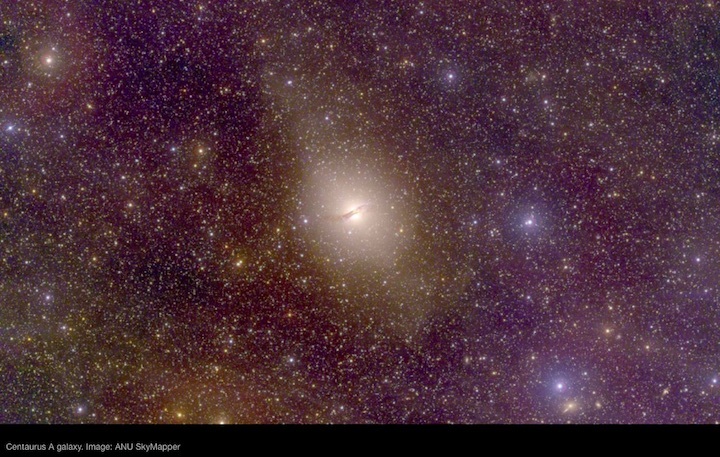2.02.2018

Cold dark matter theory made astronomers believe that the best studied galaxies in the Universe - the Milky Way and Andromeda - are the odd ones out.
-
A new international study involving ANU has found a plane of dwarf galaxies orbiting around Centaurus A in a discovery that challenges a popular theory about how dwarf galaxies are spread around the Universe.
Co-researcher Associate Professor Helmut Jerjen from ANU said astronomers had previously observed planes of dwarf galaxies whirling around our galaxy, the Milky Way, and the neighbouring Andromeda.
He said the latest finding challenged a long-held theory among cosmologists and theoreticians that there were thousands of dwarf galaxies in all directions around these large galaxies like bees swarming around a hive.
"Cold dark matter theory made astronomers believe that the best studied galaxies in the Universe - the Milky Way and Andromeda - are the odd ones out," said Dr Jerjen from the ANU Research School of Astronomy and Astrophysics.
"It seems that our Milky Way and Andromeda are normal galaxies after all, and spinning pancake-like systems of satellite galaxies are more common than scientists expected."
Dr Jerjen said dwarf galaxies were distributed in planes that were almost perpendicular to the disks of the Milky Way, Andromeda and Centaurus A.
"Even the best cosmological simulations struggle to explain the phenomenon of these small galaxies revolving in one direction around host galaxies," he said.
Dr Jerjen conducted the study in collaboration with Dr Oliver Müller from the University of Basel in Switzerland, Dr Marcel Pawlowski from the University of California, Irvine, in the United States and Dr Federico Lelli from the European Southern Observatory in Germany.
Dr Müller said it was likely most large galaxies in the Universe have had a close encounter or merged with another galaxy at least once in their life.
"Co-rotating dwarf galaxy systems could have formed during such interactions. In this scenario dwarf galaxies should be devoid of dark matter," he said.
The Milky Way and Andromeda are spiral galaxies, while Centaurus A has both elliptical and spiral features. Centaurus A is about 13 million light years away from Earth.
The most well-known dwarf galaxies around the Milky Way are the Magellanic Clouds, which are visible to the naked eye from the southern hemisphere.
"Scientists have identified close to 50 dwarf galaxy candidates around the Milky Way - most of them are aligned in a plane orbiting the centre of the host galaxy," Dr Jerjen said.
"Most of the dwarf galaxy candidates that my colleagues and I observed around Centaurus A are arranged this way, and it's a similar case with at least half of them around Andromeda."
Dr Jerjen said the latest research will have major implications for future cosmological work.
The research is published in Science.
Quelle: ANU
+++
Astronomy: a Rotating System of Satellite Galaxies Raises Questions

Astronomers have examined the distribution and movement of dwarf galaxies in the constellation Centaurus, but their observations do not fit with the standard model of cosmology that assumes the existence of dark matter. The international team of researchers led by the University of Basel reported their findings in the journal Science.
Like other large galaxies, our Milky Way is surrounded by smaller galaxies that orbit it as satellites. According to the standard model of cosmology that describes the formation of galaxies, these satellite galaxies should be distributed randomly and should orbit the host galaxy in an unordered way. The standard model assumes that all galaxies consist mainly of invisible dark matter, which has not yet been directly detected.
Observations of the Milky Way and the Andromeda galaxy, however, challenge this model: a few years ago, astronomers discovered that satellite galaxies are arranged in disc-shaped planes around the host galaxy and co-rotate within such planes.
Advocates of the standard model interpreted these structures as isolated cases. However, new findings by researchers led by Oliver Müller from the University of Basel’s Department of Physics now suggest that these are not statistical outliers, but are part of a widespread phenomenon.
Orderly movement within a plane
The researchers analyzed the movement of satellite galaxies around Centaurus A, a galaxy around 13 million light years away. The satellites are arranged on a plane that is perpendicular to the parent galaxy. This plane is oriented at a favorable angle to Earth, so the Doppler effect of the starlight can be used to determine the movement of the objects.
The researchers were thus able to show that 14 of the 16 satellite galaxies follow the same pattern of movement and are likely rotating within the plane around the main galaxy. According to model simulations with dark matter, however, only half a percent of satellite systems in the local universe at most should behave this way.
Challenge to the standard model
“Coherent movement seems to be a universal phenomenon that demands new explanations,” says Oliver Müller. The astronomical observations challenge the simulations. The possibility of coincidence can be ruled out, as this result – already seen in the Milky Way and the Andromeda galaxy – has now been detected a third time, in Centaurus A.
The standard cosmological model cannot explain the development of such structures; on the contrary, the results strengthen the supposition that satellite galaxies form during the collision of two larger galaxies, out of small debris ejected by tidal forces, as the astronomers write in the journal Science.
Quelle: University of Basel

